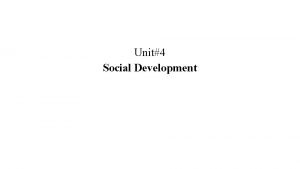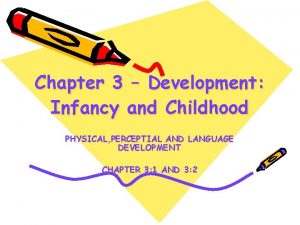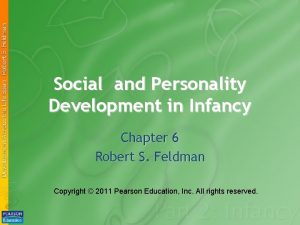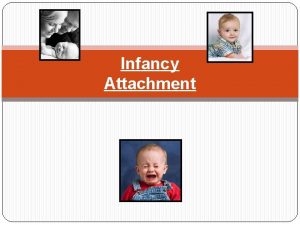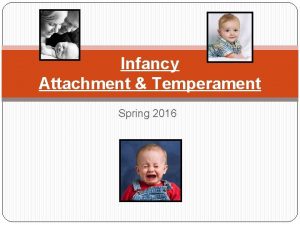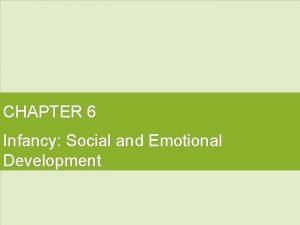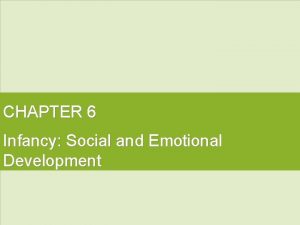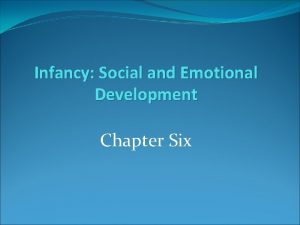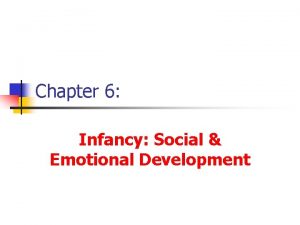INFANCY SOCIAL DEVELOPMENT Attachment Attachment an active and











- Slides: 11

INFANCY SOCIAL DEVELOPMENT

Attachment ■ Attachment- an active and intense emotional relationship between two people ■ Infants are basically helpless and dependent on others, so feelings of attachment are essential to their survival ■ Infants usually become most attached to their mothers (their primary caregivers) ■ Around 8 months some infants develop stranger anxiety- don’t like being around strangers ■ Same age they can develop Separation Anxiety- don’t like being away from their mothers

Contact Comfort ■ Psychologists long thought that infants were just attached to those who fed them. ■ Study done in which monkeys had two mothers; one wired and had milk, the other no milk but soft cloth. Monkeys chose to always be with their cloth moms. ■ Contact Comfort- the instinctual need to touch and be touched by something soft ■ This need is even stronger than the infant’s need for food ■ Contact comfort also makes infants more likely to explore as long as they know their mother is close by

Imprinting ■ Imprinting- the process by which some animals form immediate attachments during a critical period ■ For example, ducks and geese become attached to the first moving object they see ■ It takes several months for humans to become attached to their main caregivers, it is not immediate like other animals

Secure vs Insecure Attachments ■ When caregivers are affectionate and reliable, infants. become securely attached. Meaning they are very bonded to them ■ They cry when the caregiver leaves and are happy when they return. ■ Unresponsive caregivers lead to insecurely attached infants. They don’t mind when the caregiver leaves and don’t really care to make contact with them when they return. ■ Secure infants usually mature into secure children, who are happier, friendlier, and do better in school than insecure children.

Styles of Parenting Strict Permissive Cold Warm Demanding Controlling Dictatorial Antagonistic Lenient Democratic Inconsistent Overindulgent Indifferent Careless Detached Inattentive Affectionate Supportive Protective Caring ■ Research suggest that children fare better with warm parents in the long run. More likely to have a better sense of right and wrong. Children of cold parents usually just try to escape punishment instead.

Child Abuse and Neglect ■ Child abuse-physical, sexual, and psychological- is relatively widespread even though it is seriously underreported. ■ More health problems and deaths result from neglect than from child abuse ■ Studies show that children who are abused are at a higher risk of developing psych problems. ■ Child abuse tends to run in families ■ But it can be broken. With the care from a non abusive adult, therapy, and having a non abusive partner.

Self Esteem ■ Self Esteem- the value or worth that people attach to themselves ■ By the age of seven, children begin to value themselves on physical appearance and performance in school ■ Girls display greater competence in reading and general academic skills ■ Boys display competence in math and physical skills ■ The reason may point to people around them suggesting that this is what they are SUPPOSED to be good at ■ Girls think they will do better on tasks labeled feminine ■ Boys do better on tasks labeled masculine ■ People generally live up to the expectations that they have and others have for them

Attachment Writing ■ Imagine a world in which all newborns are raised by robots in a separate facility, where they do not have contact with their parents or other humans. ■ How is the world depicted in the story different from the world in which we live? ■ How would your life be different if you had been raised in such a world?

Parenting Writing ■ Brainstorm a hypothetical incident between a parent and child. For example, the child steals a candy bar from the display at the supermarket. (Don’t steal my example) ■ Consider the four parenting style combinations: warmpermissive, warm-strict, cold-permissive, and cold-strict. ■ How would a parent from each combination react to the situation? ■ What are some possible effects on the child based off the parent’s reaction?

Questions 1. Name and describe the two types of anxiety that strike infants around the age of eight months. 2. What does it mean f or a child to be insecurely attached, and what can be the result for the child? 3. What do you think children who have been abused are more likely to suffer from psychological problems, such as anxiety, depression, and low self esteem? 4. How do you think boys and girls can be helped to display competence in areas that they presently do not? 5. What combination of parenting qualities do you think is best for raising a child? What combination of parenting qualities are you likely to exhibit based on your personality?
 Social development in infancy
Social development in infancy Intellectual meaning health and social
Intellectual meaning health and social Module 47 infancy and childhood cognitive development
Module 47 infancy and childhood cognitive development 6 life stages
6 life stages Infancy and childhood physical development
Infancy and childhood physical development Rovee-collier
Rovee-collier Module 47 infancy and childhood cognitive development
Module 47 infancy and childhood cognitive development Chapter 5 cognitive development in infancy and toddlerhood
Chapter 5 cognitive development in infancy and toddlerhood Socioemotional development in infancy
Socioemotional development in infancy Infancy psychosocial development
Infancy psychosocial development Stages of growth and development
Stages of growth and development Personality development in infancy
Personality development in infancy
